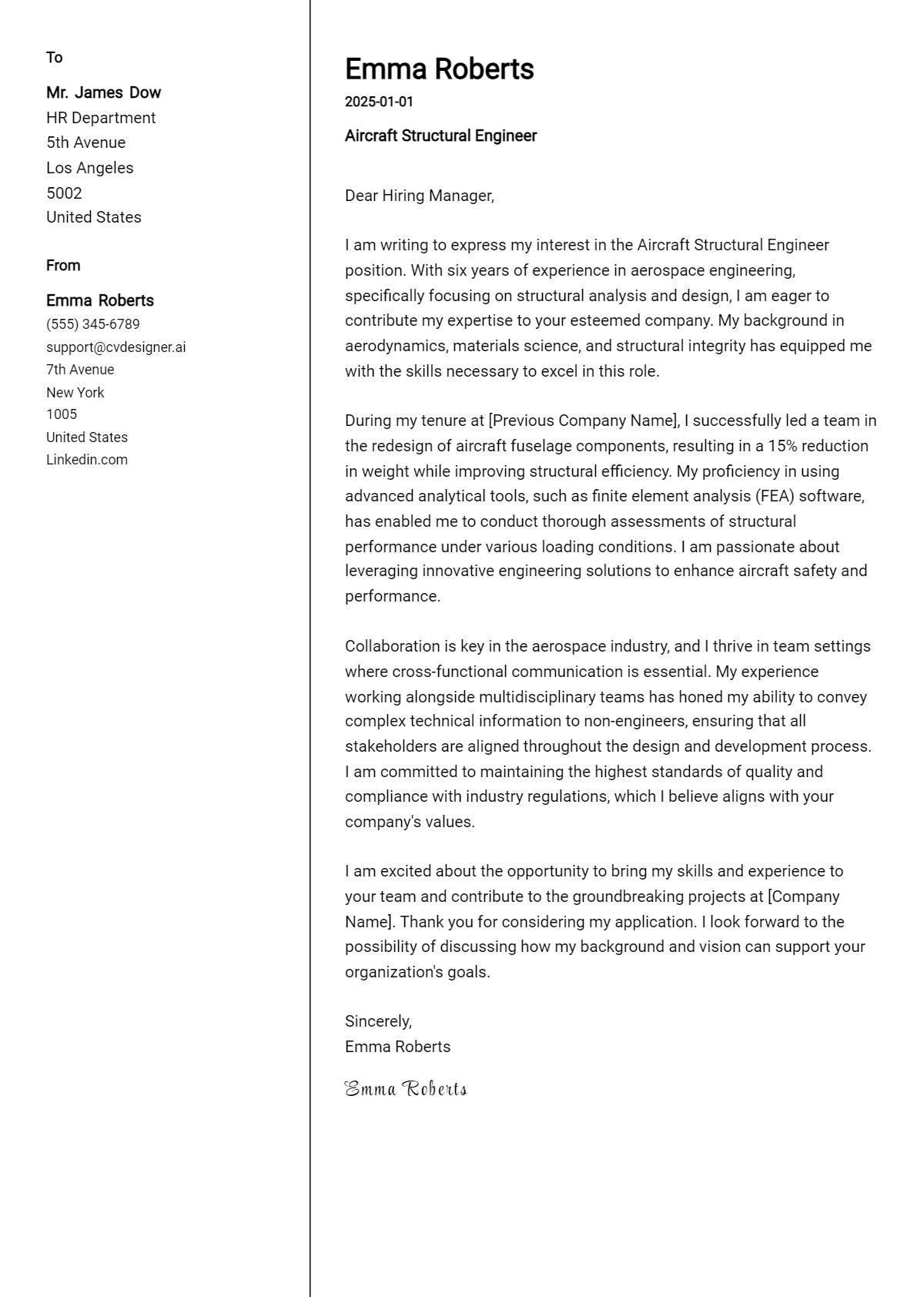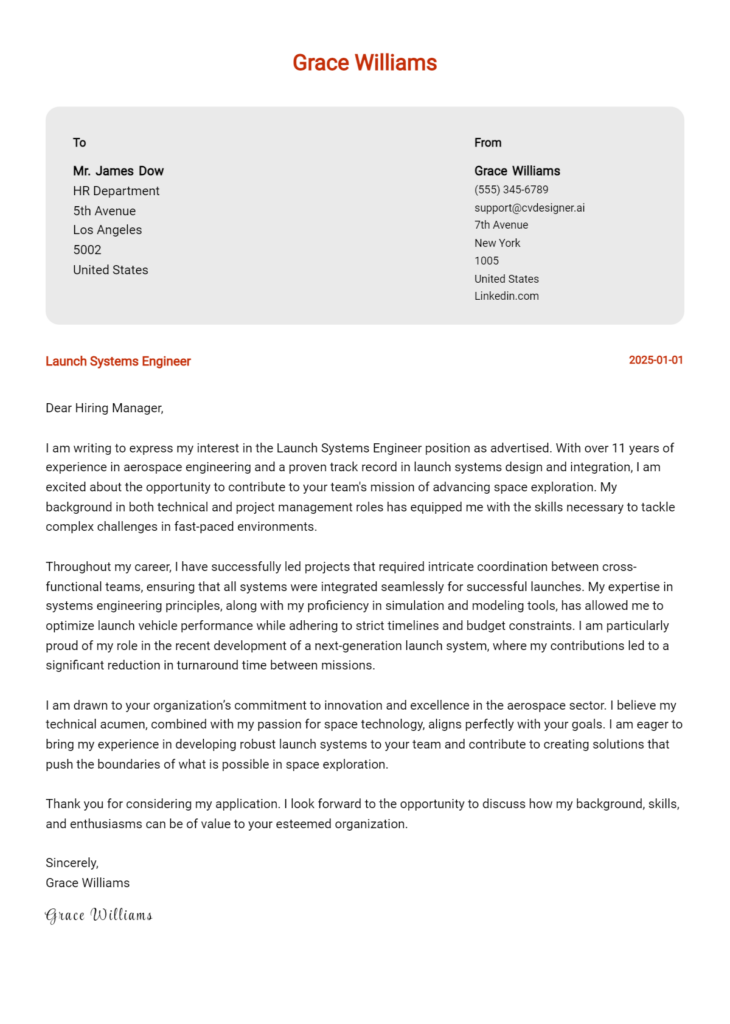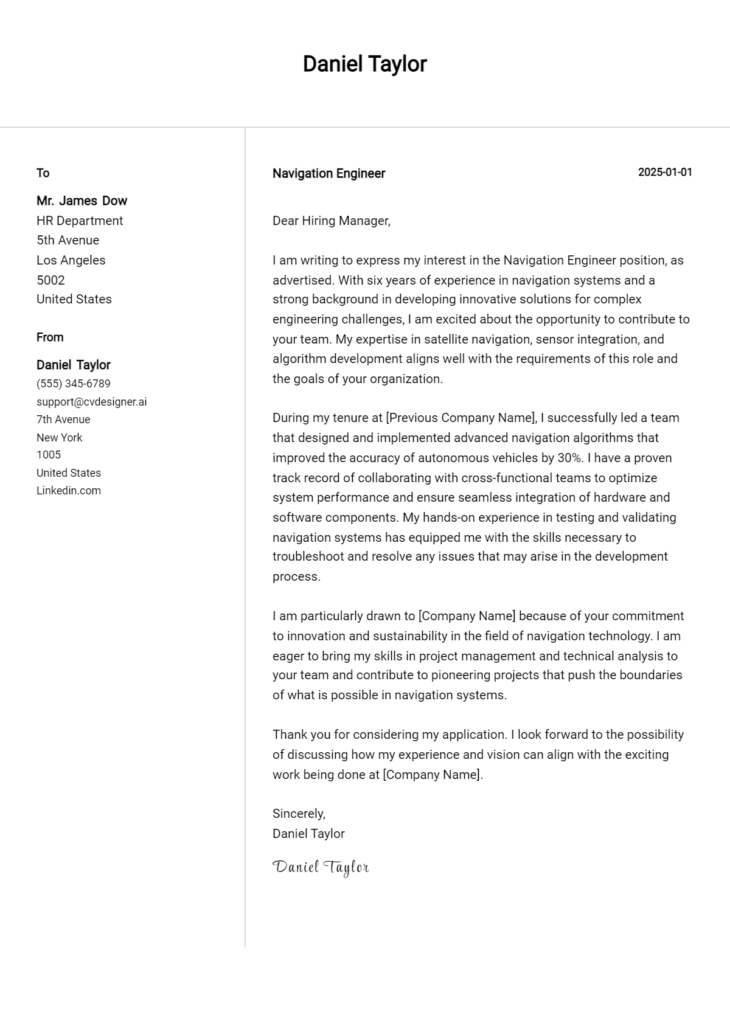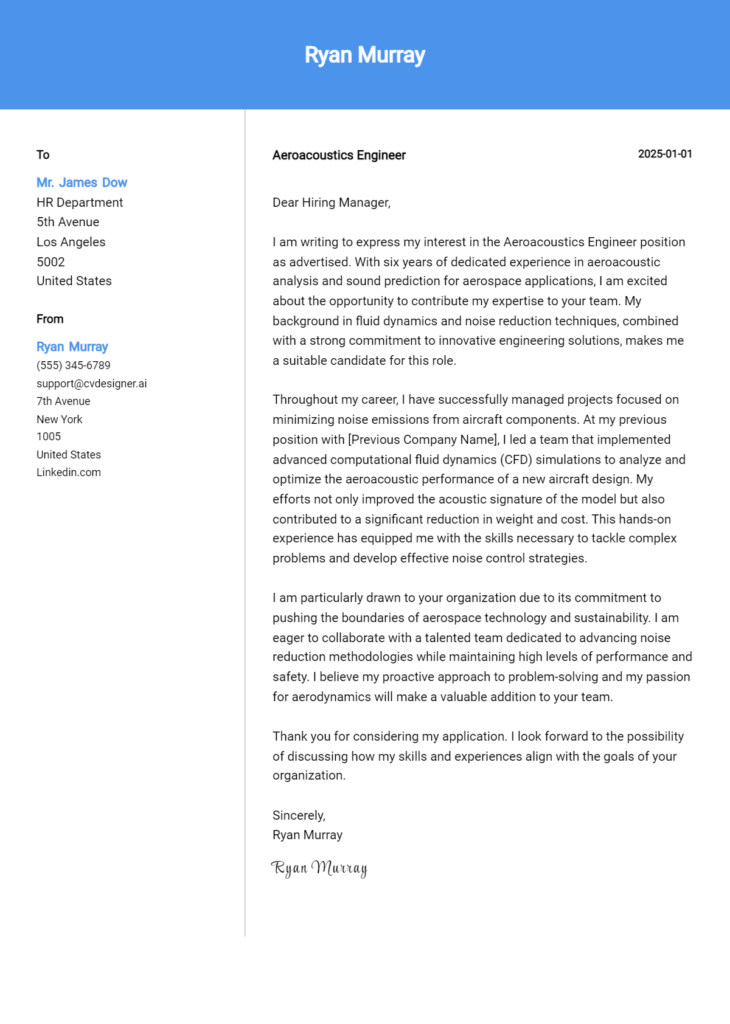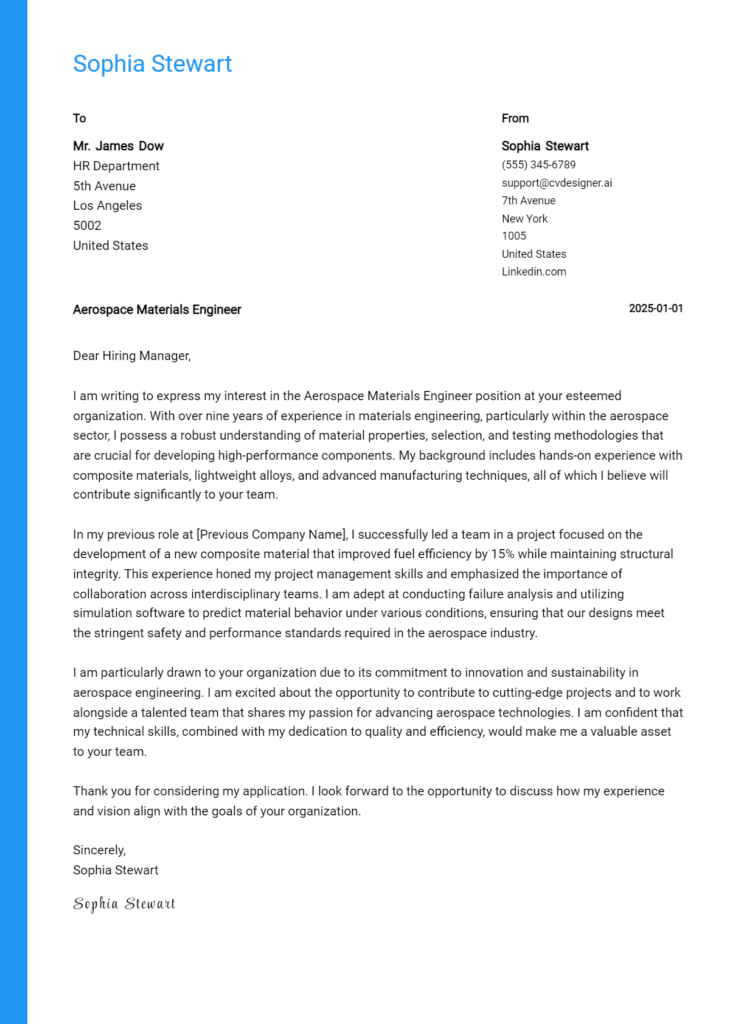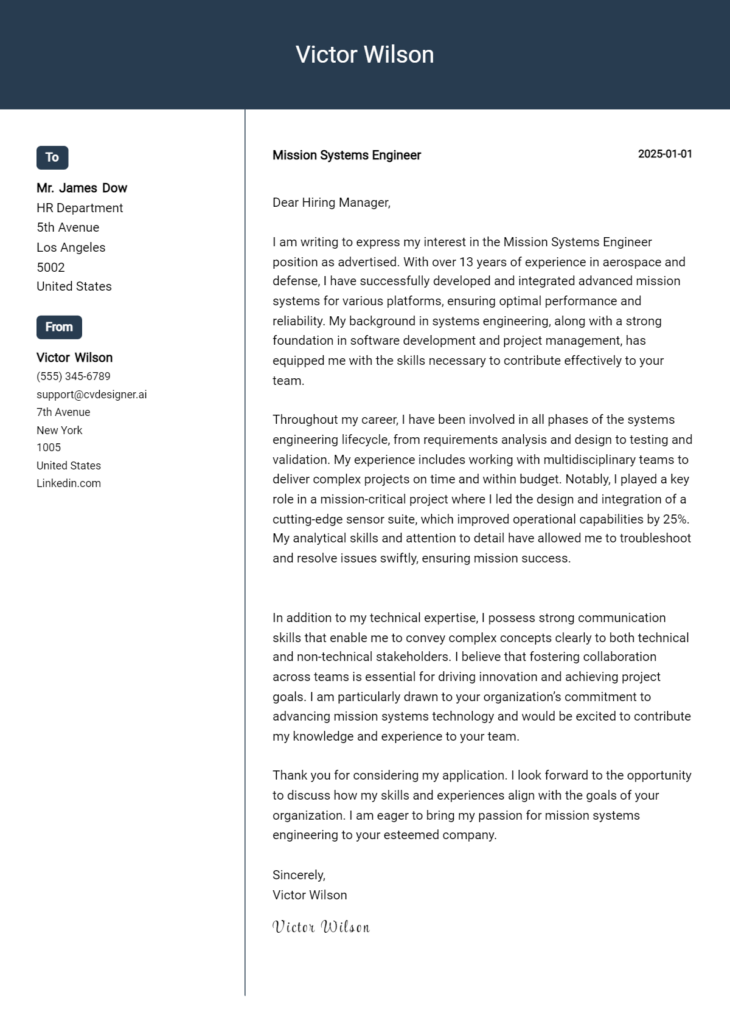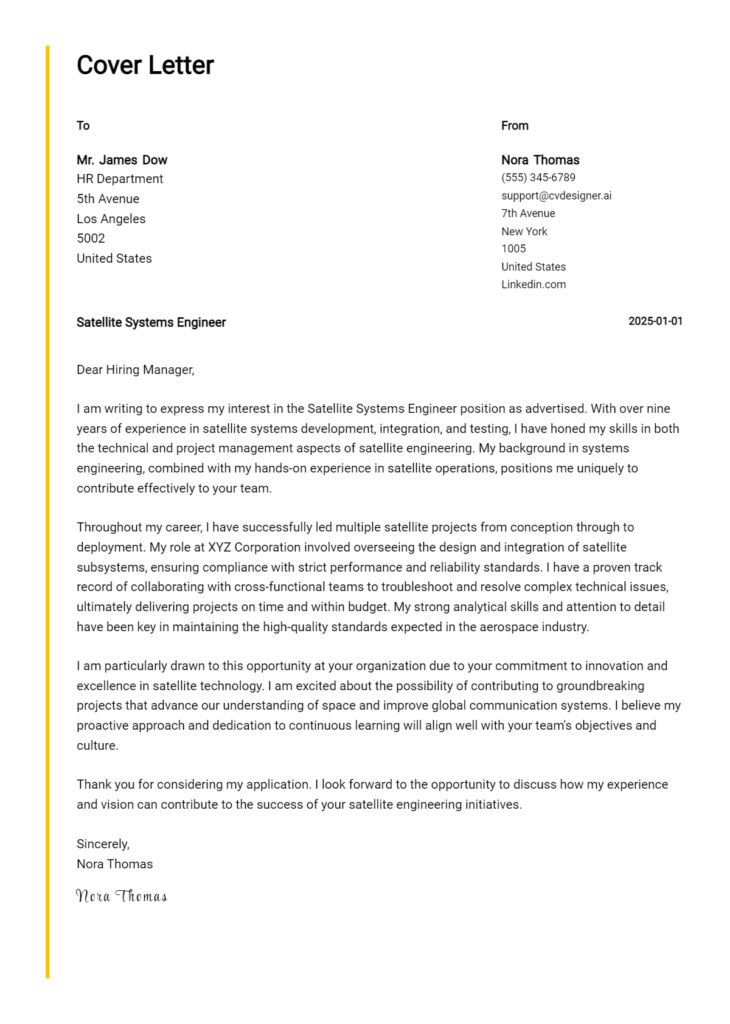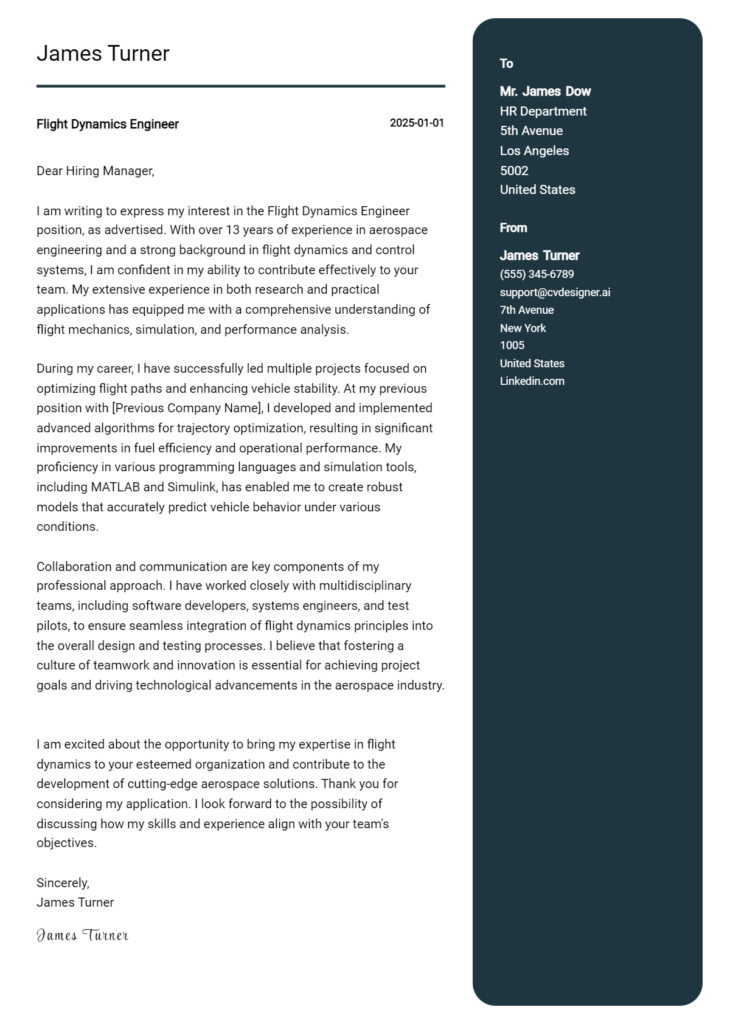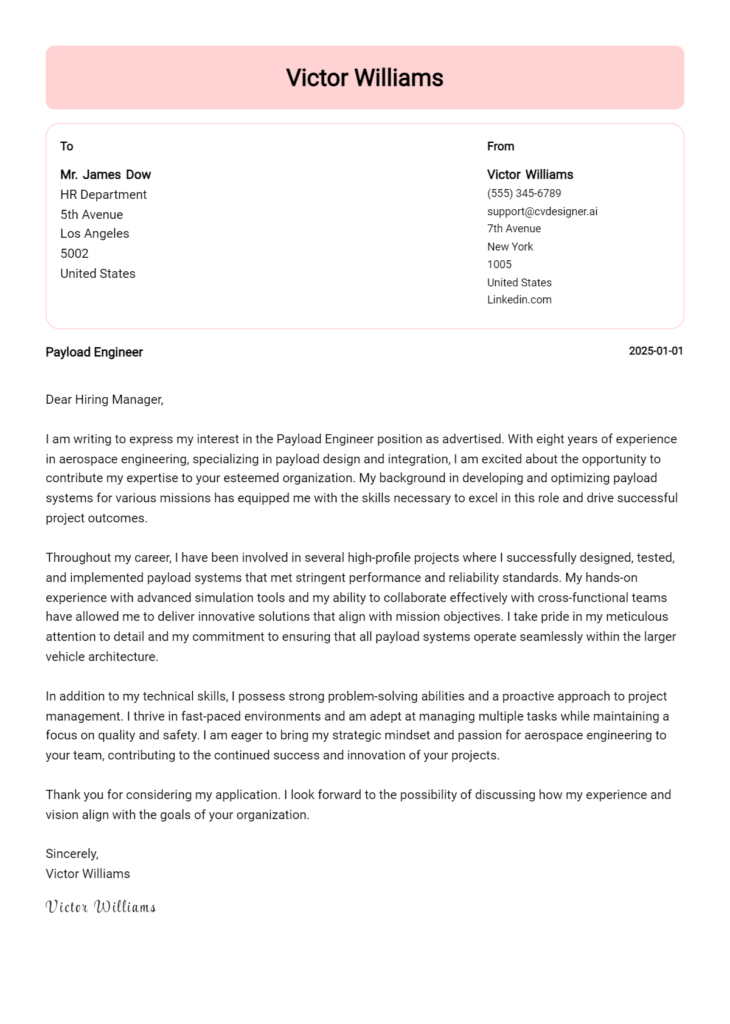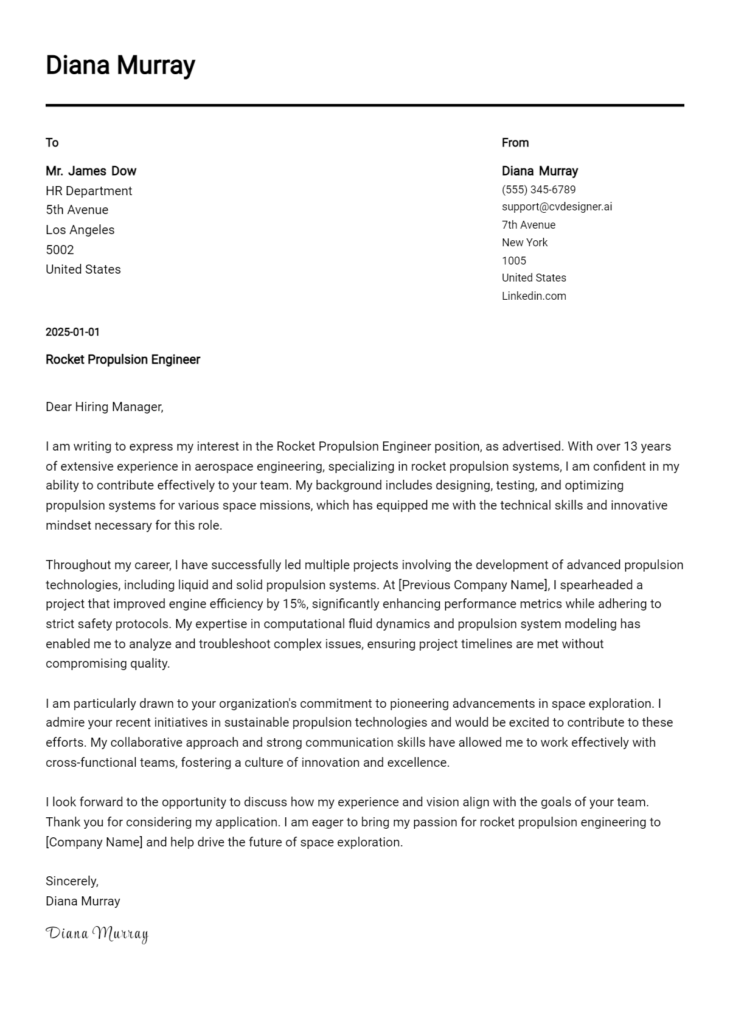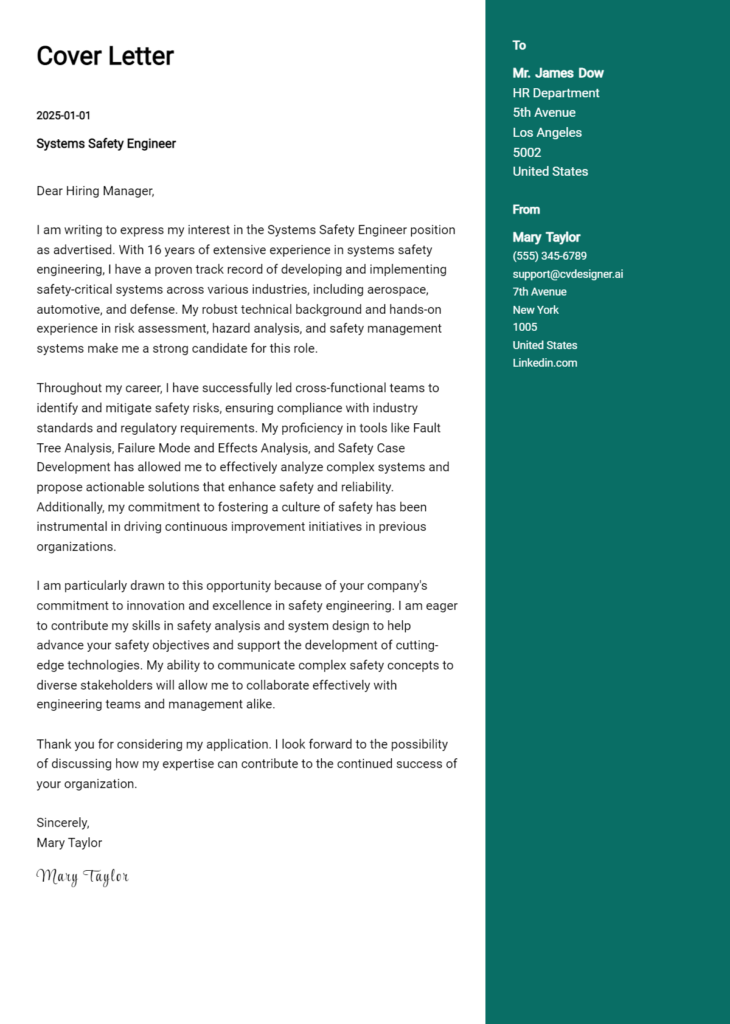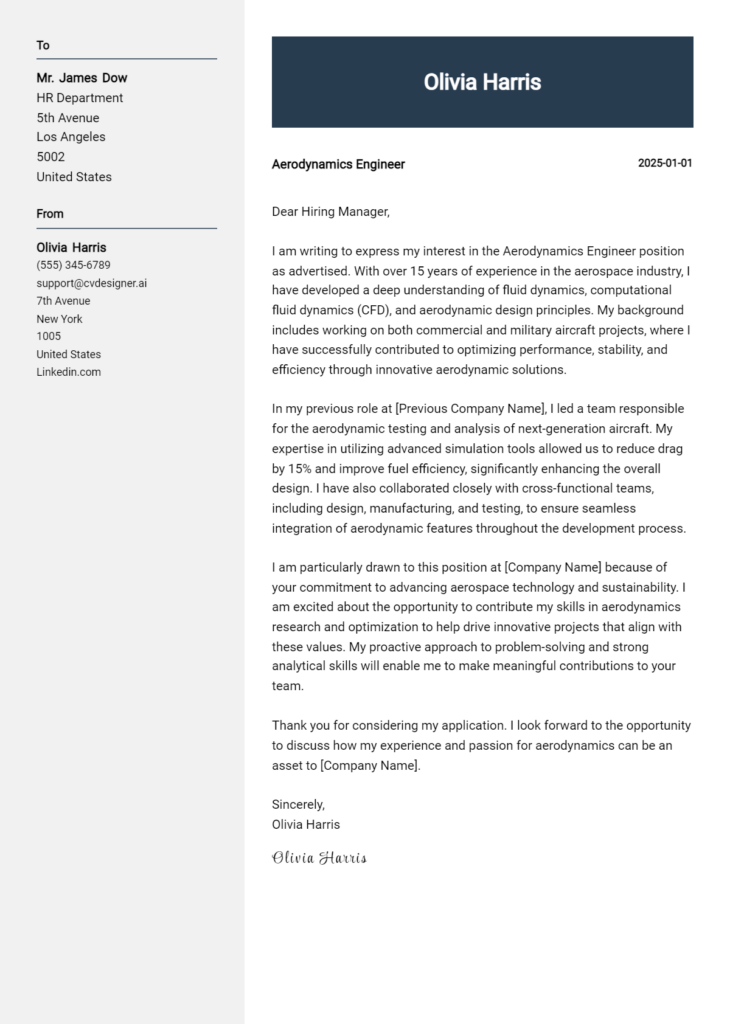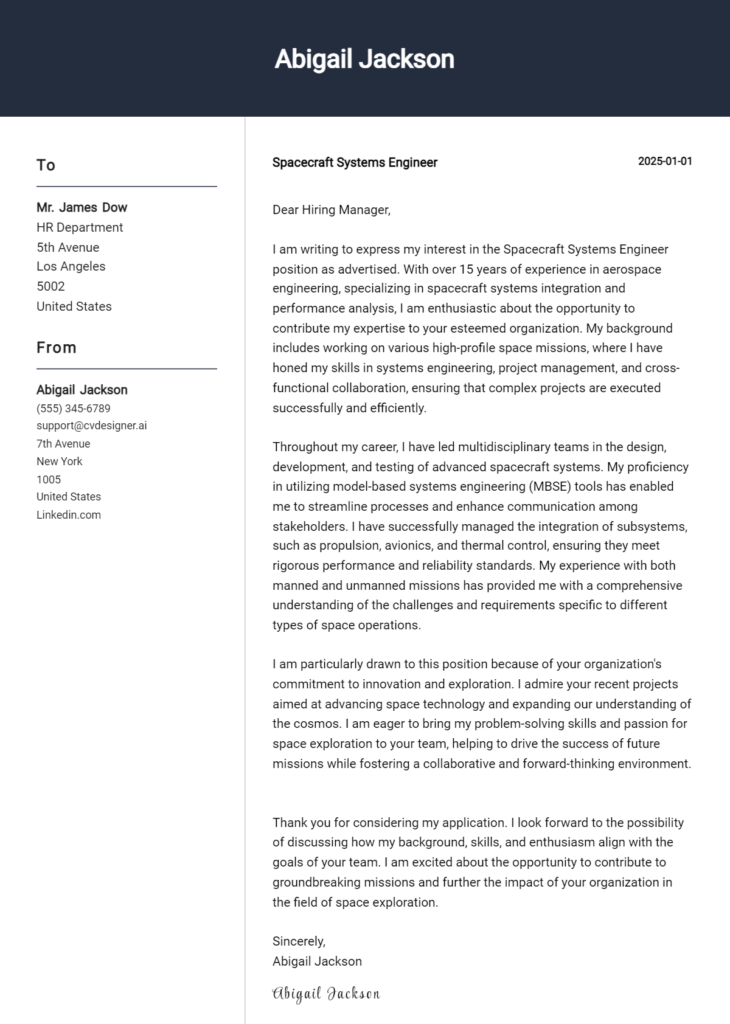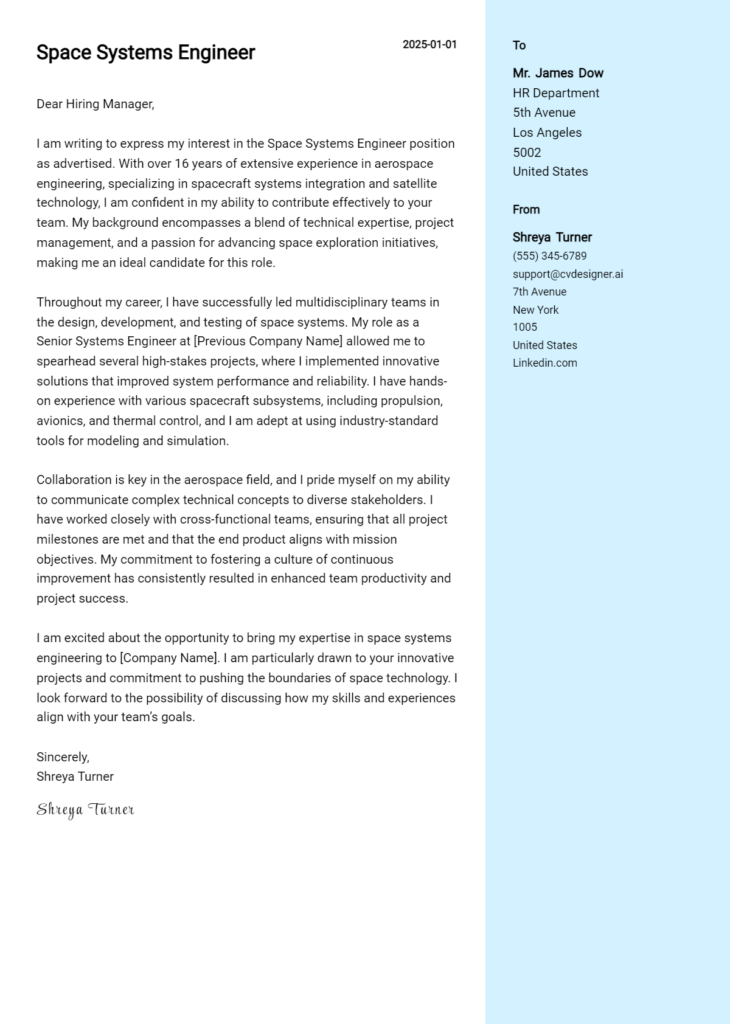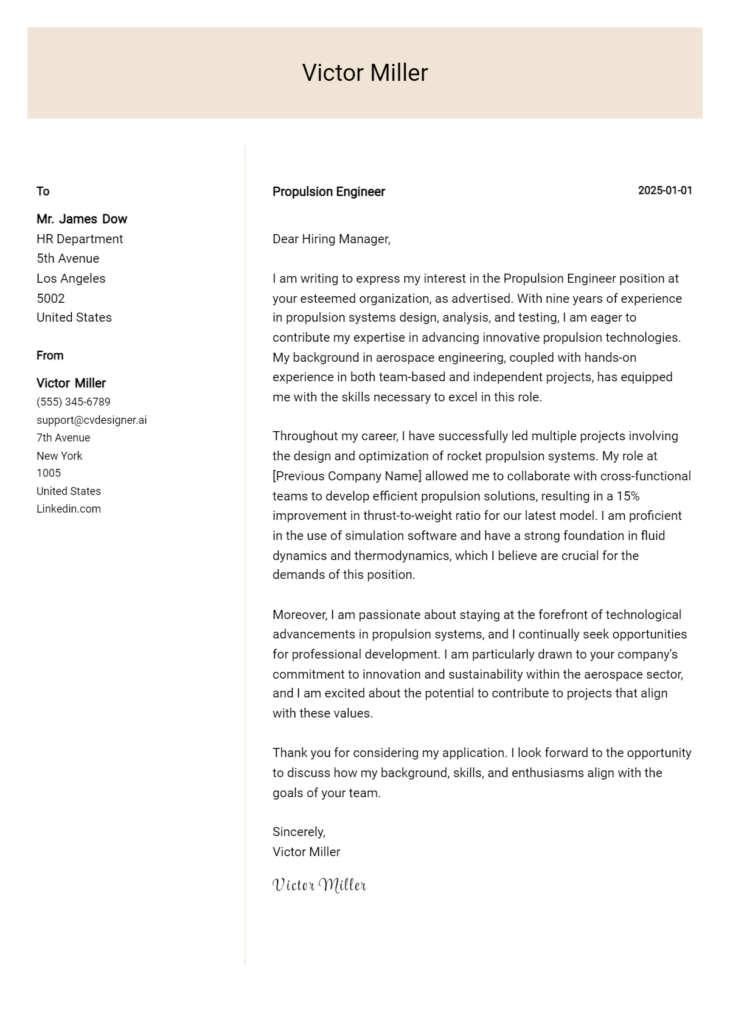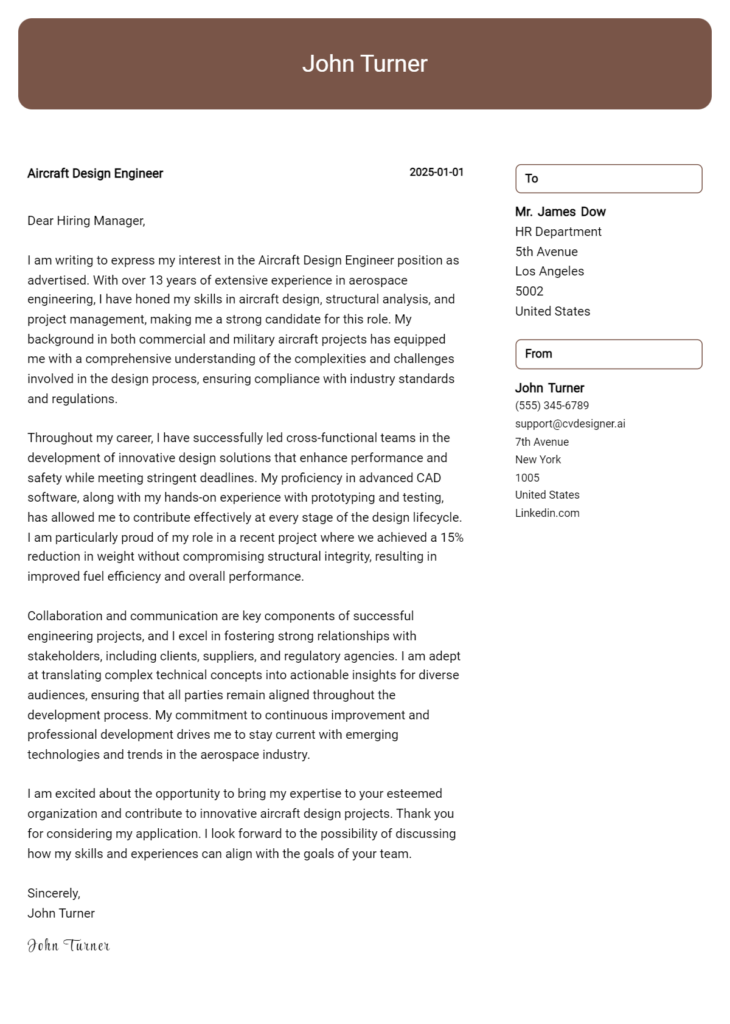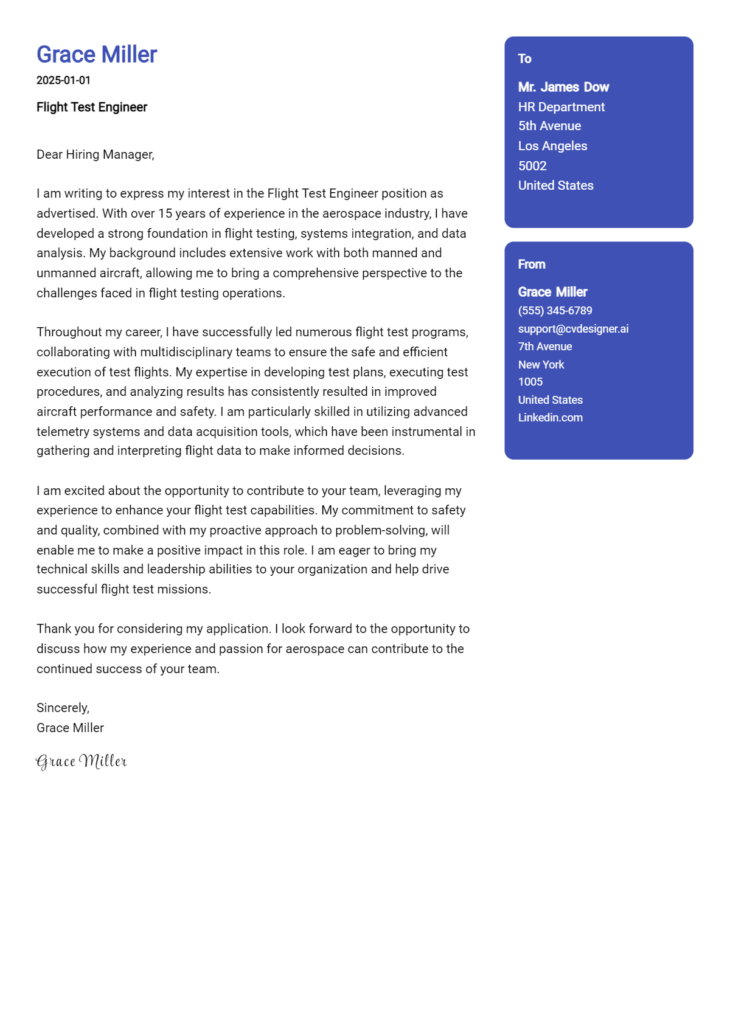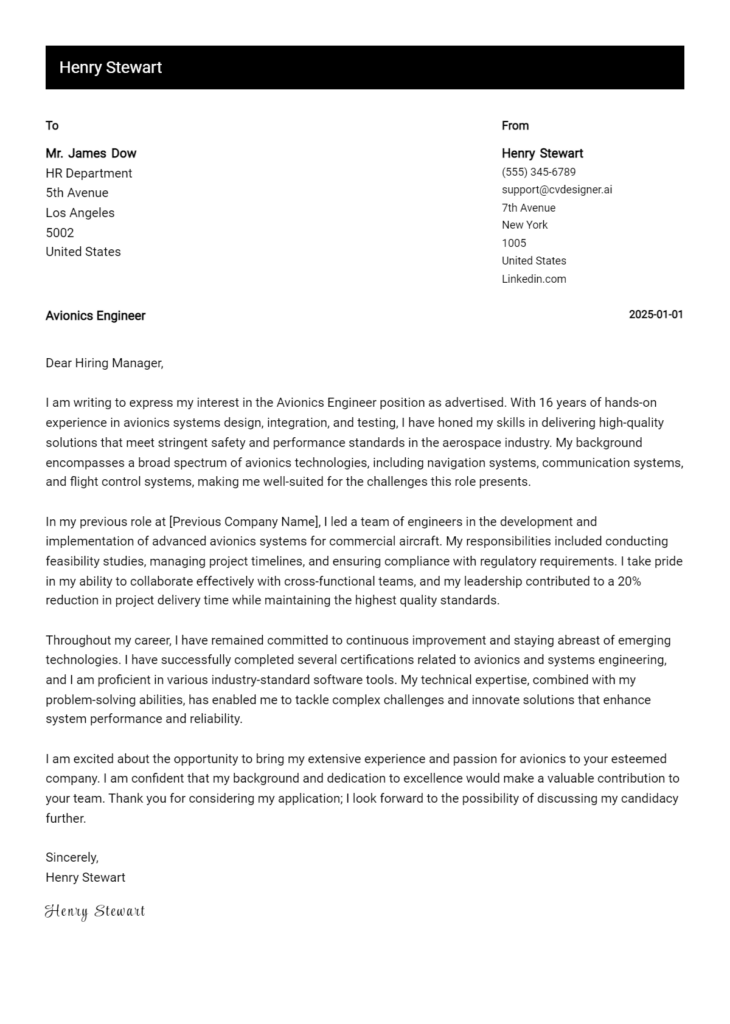Aircraft Structural Engineer Cover Letter Examples
Explore additional Aircraft Structural Engineer cover letter samples and guides and see what works for your level of experience or role.
How to Format an Aircraft Structural Engineer Cover Letter
Crafting a compelling cover letter is essential for an Aircraft Structural Engineer, as it serves as your first impression to potential employers. The way you format your cover letter not only communicates your technical skills but also illustrates your attention to detail and adherence to industry standards—qualities that are vital in aerospace engineering. A well-structured cover letter enhances readability and allows you to effectively showcase your qualifications, making it easier for hiring managers to recognize your suitability for the role.
In this guide, we will explore the key components of a professional cover letter, focusing on:
- Cover Letter Header
- Cover Letter Greeting
- Cover Letter Introduction
- Cover Letter Body
- Cover Letter Closing
Each section is crucial in portraying your expertise and professionalism. Let’s delve into the specifics of how to make your Aircraft Structural Engineer cover letter stand out.
Importance of the Cover Letter Header for an Aircraft Structural Engineer
The cover letter header is a crucial component that sets the tone for your application as an Aircraft Structural Engineer. It provides essential contact information, ensuring that the hiring manager can easily reach you. A well-structured header includes your name, address, phone number, email, the date, and the recipient's details, such as their name and title. Clarity and professionalism in the header reflect your attention to detail and seriousness about the position, which are vital traits for an engineer. A strong header can make a positive first impression, while a poorly formatted one may suggest carelessness.
Strong Example
John Doe 123 Engineering Lane Aviation City, AC 12345 (123) 456-7890 john.doe@email.com March 15, 2023 Ms. Jane Smith Hiring Manager Aviation Solutions Inc. 456 Industry Road Aviation City, AC 12345
Weak Example
john doe 123 engineering lane (123) 456-7890 March 15, 2023 Aviation Solutions Inc.
The Importance of the Cover Letter Greeting for an Aircraft Structural Engineer
The greeting of your cover letter is crucial as it sets the tone for the rest of your application. A well-crafted greeting not only demonstrates your professionalism but also shows your interest in the specific position and company. By addressing the hiring manager directly, you personalize your letter, making it more engaging and impactful. To avoid generic greetings, take the time to research the recipient's name and title; this attention to detail reflects your commitment and enthusiasm for the role. For example, instead of a vague "To Whom It May Concern," a specific greeting can create a stronger connection.
Strong Greeting Example
Dear Mr. Johnson,
Weak Greeting Example
To Whom It May Concern,
The Importance of a Well-Crafted Cover Letter Introduction for an Aircraft Structural Engineer
A well-crafted cover letter introduction is crucial for an Aircraft Structural Engineer as it sets the tone for the entire application. This opening paragraph should not only grab the attention of the hiring manager but also convey the candidate's genuine interest in the position. Additionally, it should highlight key skills or notable achievements that align with the job requirements. A strong introduction can effectively differentiate a candidate in a competitive job market, while a weak one may lead to the application being overlooked.
Strong Example
Dear [Hiring Manager's Name], I am excited to apply for the Aircraft Structural Engineer position at [Company Name]. With over five years of experience in aerospace engineering and a proven track record of successfully leading structural integrity assessments, I am confident in my ability to contribute to your team. My recent project, where I enhanced the durability of wing structures, resulted in a 15% increase in overall safety ratings, underscoring my commitment to excellence in aircraft design and safety.
Weak Example
Dear [Hiring Manager's Name], I want to apply for the Aircraft Structural Engineer job. I have some experience in engineering and I think I can do the job. I have worked on different projects, but I haven’t really done anything specific for aircraft before.
Cover Letter Body for Aircraft Structural Engineer
The body of a cover letter for an Aircraft Structural Engineer is crucial in demonstrating the candidate's technical skills, relevant experiences, and the unique value they bring to the organization. This section serves as an opportunity to highlight specific projects or accomplishments that showcase the candidate's ability to contribute effectively to the company’s goals. By detailing successes in previous roles—such as optimizing aircraft structures for weight reduction or leading a team in a critical repair project—the candidate can effectively illustrate their expertise and problem-solving capabilities. A well-crafted body not only outlines qualifications but also aligns the candidate’s background with the needs of the employer, making a compelling case for their hire.
Strong Example
I am excited to apply for the Aircraft Structural Engineer position at ABC Aviation, as I believe my background in advanced composite materials and structural analysis will be an asset to your team. At XYZ Aerospace, I led a project that successfully reduced the weight of the wing structures by 15% through innovative design modifications and the implementation of new materials. This not only improved fuel efficiency but also resulted in a cost savings of over $500,000 during production. Additionally, my experience with finite element analysis has allowed me to identify and resolve potential structural failures early in the design process, ensuring safety and reliability in all projects I oversee. I am eager to bring my expertise and passion for aerospace engineering to ABC Aviation, contributing to your mission of delivering high-quality aircraft solutions.
Weak Example
I am applying for the Aircraft Structural Engineer job because I have some experience in aerospace. I worked on a few projects that involved aircraft structures. I think I could help your company with some engineering tasks. I am good at working with teams, and I can solve problems when they come up. I hope to bring my skills to your organization and learn more about aircraft design.
Importance of the Cover Letter Closing for an Aircraft Structural Engineer
The closing paragraph of a cover letter is crucial for leaving a lasting impression on the hiring manager. It serves to summarize your qualifications, reiterate your enthusiasm for the position, and encourage the next steps, such as reviewing your resume or scheduling an interview. A strong closing can effectively convey your eagerness and confidence in being a fit for the role, while a weak closing may leave the reader uncertain about your interest or qualifications.
Strong Example
Thank you for considering my application for the Aircraft Structural Engineer position at [Company Name]. With my extensive background in structural analysis and design, coupled with my passion for aviation, I am excited about the opportunity to contribute to your team. I am looking forward to the possibility of discussing how my skills and experiences align with the needs of your organization. Please feel free to review my attached resume, and I hope to schedule a meeting at your earliest convenience. Thank you once again for your time and consideration.
Weak Example
I hope you think about my application. I have worked on some aircraft projects and I think I can do the job. Please look at my resume. Thanks for your time.
These tips are designed to assist candidates in crafting an effective cover letter for the role of Aircraft Structural Engineer. A well-written cover letter should not only reflect your technical expertise but also demonstrate your problem-solving abilities, understanding of the Software Development Life Cycle (SDLC), collaboration skills, and dedication to continuous learning. By following these tips, you can create a compelling narrative that highlights your qualifications and passion for the aerospace industry.
Cover Letter Writing Tips for Aircraft Structural Engineer
Highlight Your Technical Skills: Begin your cover letter by emphasizing your technical skills relevant to aircraft structures. Mention your proficiency in structural analysis, materials science, and design software such as CATIA or SolidWorks. Providing specific examples of projects where you utilized these skills can make your application stand out.
Showcase Problem-Solving Abilities: Aircraft Structural Engineers often face complex challenges that require innovative solutions. Use your cover letter to describe a particular problem you encountered in your previous roles and how you approached it. Highlight the steps you took to resolve the issue and the outcome, showcasing your analytical thinking and resourcefulness.
Demonstrate Knowledge of the SDLC: Understanding the Software Development Life Cycle (SDLC) is crucial in today's aerospace industry. Illustrate your familiarity with SDLC phases, and discuss how you’ve integrated software tools into your engineering processes. This knowledge not only shows your technical competency but also your ability to work in modern engineering environments.
Emphasize Teamwork and Collaboration: Aircraft design and maintenance are collaborative efforts that require effective communication and teamwork. Share examples of successful collaborations with cross-functional teams, detailing your role and contributions in achieving project goals. This will highlight your interpersonal skills and ability to work in a team-oriented environment.
Express a Passion for Continuous Learning: The aerospace industry is constantly evolving, and a commitment to continuous learning is essential. Mention any recent certifications, courses, or conferences you’ve attended that relate to aircraft engineering. This demonstrates your proactive approach to professional development and your desire to stay updated on industry trends.
For further assistance in crafting your cover letter, consider using our cover letter templates or trying out our cover letter builder. These resources can help streamline the writing process and ensure that your cover letter is both professional and impactful.
Common Mistakes to Avoid in an Aircraft Structural Engineer Cover Letter
Crafting a compelling cover letter is essential for standing out in the competitive field of Aircraft Structural Engineering. Avoiding common mistakes can significantly enhance your chances of making a positive impression on hiring managers. Here are some pitfalls to steer clear of, along with tips on how to avoid them:
Generic Language: Using a one-size-fits-all approach can be detrimental. Tailor your cover letter to the specific job and company. Mention the company name and refer to the job description to show genuine interest.
Lack of Specificity: Failing to provide concrete examples of your skills and accomplishments can weaken your application. Use specific examples from your experience that directly relate to the requirements of the Aircraft Structural Engineer role.
Ignoring Format: A poorly formatted cover letter can distract from your qualifications. Ensure you follow a professional cover letter format that is easy to read and visually appealing.
Excessive Length: Being overly verbose can lead to your cover letter being overlooked. Keep it concise—ideally one page—focusing on key achievements and skills relevant to the position.
Neglecting Proofreading: Spelling and grammatical errors can undermine your professionalism. Always proofread your cover letter multiple times, and consider asking a friend or mentor to review it.
Failure to Show Enthusiasm: A lack of enthusiasm can make you seem indifferent. Convey your passion for the field and the specific company, demonstrating why you want to join their team.
Overlooking the Call to Action: Not including a call to action can leave the reader unsure of the next steps. Politely express your desire for an interview and thank them for considering your application.
By steering clear of these common mistakes and following best practices, you can create a standout cover letter that captures the attention of hiring managers. For additional guidance, consider checking out cover letter examples to inspire your own writing.
Cover Letter FAQs for Aircraft Structural Engineer
What should I include in my cover letter as an Aircraft Structural Engineer?
In your cover letter, you should include a strong introduction that specifies the position you're applying for and how you learned about it. Follow this with a brief overview of your relevant experience, focusing on specific projects or roles that highlight your skills in structural analysis, materials science, and design principles. Mention any certifications or technical skills, such as proficiency in CAD software and knowledge of aerospace standards. Additionally, express your passion for the aerospace industry and how your values align with the company’s mission. Finally, conclude with a call to action, inviting the hiring manager to discuss your application further.
How can I tailor my cover letter for a specific job application?
To tailor your cover letter, start by researching the company and the specific role. Analyze the job description to identify key skills and requirements. Reflect those keywords in your cover letter by providing examples of how you meet those criteria. Highlight any relevant projects or experiences that demonstrate your expertise, such as successful structural designs or problem-solving cases in previous positions. Additionally, mention any knowledge of the company’s products or projects, showing that you have a genuine interest in their work. Personalizing your letter in this way can significantly increase your chances of making a positive impression.
How long should my cover letter be for an Aircraft Structural Engineer position?
Your cover letter should ideally be one page long, typically consisting of three to four paragraphs. Aim for a concise and focused approach, ensuring that every sentence adds value. Start with a compelling introduction, followed by a few paragraphs detailing your relevant experience and skills. Use bullet points if necessary to highlight key achievements or qualifications. Finally, wrap up with a strong conclusion that reiterates your enthusiasm for the position and encourages the hiring manager to reach out. Keeping it succinct yet informative will maintain the reader's attention and convey your professionalism.
Should I include technical jargon in my cover letter?
Including technical jargon can be beneficial, but it should be used judiciously. As an Aircraft Structural Engineer, demonstrating your knowledge of industry-specific terms can showcase your expertise. However, be mindful of your audience; if the hiring manager may not have a technical background, overly complex language could hinder clear communication. Strike a balance by using technical terms that are essential to your qualifications and experiences while ensuring your letter remains accessible. Consider briefly explaining any necessary jargon to clarify your points. Ultimately, your goal is to communicate your qualifications effectively without alienating the reader.
Build your Cover Letter in minutes
Use an AI-powered cover letter builder and have your letter done in 5 minutes. Just select your template and our software will guide you through the process.

